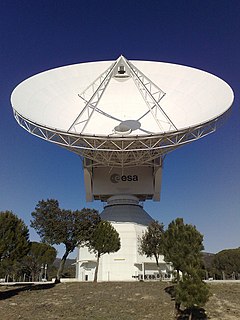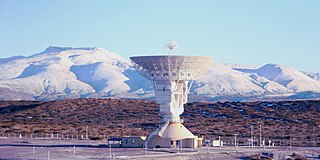
The Mars Observer spacecraft, also known as the Mars Geoscience/Climatology Orbiter, was a robotic space probe launched by NASA on September 25, 1992, to study the Martian surface, atmosphere, climate and magnetic field. During the interplanetary cruise phase, communication with the spacecraft was lost on August 21, 1993, three days prior to orbital insertion. Attempts to re-establish communication with the spacecraft were unsuccessful.

Mars 1, also known as 1962 Beta Nu 1, Mars 2MV-4 and Sputnik 23, was an automatic interplanetary station launched in the direction of Mars on November 1, 1962, the first of the Soviet Mars probe program, with the intent of flying by the planet at a distance of about 11,000 km (6,800 mi). It was designed to image the surface and send back data on cosmic radiation, micrometeoroid impacts and Mars' magnetic field, radiation environment, atmospheric structure, and possible organic compounds.

The Magellan spacecraft, also referred to as the Venus Radar Mapper, was a 1,035-kilogram (2,282 lb) robotic space probe launched by NASA of the United States, on May 4, 1989, to map the surface of Venus by using synthetic aperture radar and to measure the planetary gravitational field.

Pioneer 5 was a spin-stabilized space probe in the NASA Pioneer program used to investigate interplanetary space between the orbits of Earth and Venus. It was launched on March 11, 1960 from Cape Canaveral Air Force Station Launch Complex 17A at 13:00:00 UTC with an on-orbit dry mass of 43 kg. It was a 0.66 m diameter sphere with 1.4 m span across its four solar panels and achieved a solar orbit of 0.806 × 0.995 AU.

The Goldstone Deep Space Communications Complex (GDSCC), commonly called the Goldstone Observatory, is a satellite ground station located in the Mojave Desert near Barstow in the U.S. state of California. Operated by NASA's Jet Propulsion Laboratory (JPL), its main purpose is to track and communicate with space missions. It is named after Goldstone, California, a nearby gold-mining ghost town.

The interplanetary Internet is a conceived computer network in space, consisting of a set of network nodes that can communicate with each other. Communication would be greatly delayed by the great interplanetary distances, so the IPN needs a new set of protocols and technology that are tolerant to large delays and errors. Although the Internet as it is known today tends to be a busy network of networks with high traffic, negligible delay and errors, and a wired backbone, the interplanetary Internet is a store and forward network of internets that is often disconnected, has a wireless backbone fraught with error-prone links and delays ranging from tens of minutes to even hours, even when there is a connection.

The International Cometary Explorer (ICE) spacecraft, was launched August 12, 1978, into a heliocentric orbit. It was one of three spacecraft, along with the mother/daughter pair of ISEE-1 and ISEE-2, built for the International Sun-Earth Explorer (ISEE) program, a joint effort by NASA and ESRO/ESA to study the interaction between the Earth's magnetic field and the solar wind.

The Madrid Deep Space Communications Complex (MDSCC) is a ground station located in Robledo de Chavela, Spain, and operated by the Instituto Nacional de Técnica Aeroespacial (INTA).

Cebreros Station is a European Space Agency, ESTRACK radio antenna station for communication with spacecraft, located about 10 km east of Cebreros and 90 km from Madrid, Spain, operated by the European Space Operations Centre and INTA. A 35-metre diameter antenna that receives and transmit in X- and Ka-bands is located at the site. Station code is "CEB". 20kW CW High Power Amplifier (HPA) it was created by Rheinmetall Italia SpA (Italy). The monitoring and control system was implemented by Microsis srl (Italy).
The Indian Space Research Organisation (ISRO), over the years, has established a comprehensive global network of ground stations to provide Telemetry, Tracking and Command (TTC) support to satellite and launch vehicle missions. These facilities are grouped under ISRO Telemetry, Tracking and Command Network (ISTRAC) with its headquarters at Bangalore, India.

Space Flight Operations Facility (SFOF) is a control room and related communications equipment areas at the Jet Propulsion Laboratory in Pasadena, California. NASA's Deep Space Network is operated from this facility. The SFOF has monitored and controlled all interplanetary and deep space exploration for NASA and other international space agencies since 1963. The facility also acted as a backup communications facility for Apollo missions.
The Manned Space Flight Network was a set of tracking stations built to support the American Mercury, Gemini, Apollo, and Skylab space programs.

This article incorporates public domain material from websites or documents of the National Aeronautics and Space Administration.
The Soviet Deep Space Network is a network of large antennas and communication facilities that supports interplanetary spacecraft missions, and radio and radar astronomy observations for the exploration of the solar system and the universe. It was built to support the space missions of the Soviet Union. Similar networks are run by the USA, China, Europe, Japan, and India.

The Mars Orbiter Mission (MOM), also called Mangalyaan, is a space probe orbiting Mars since 24 September 2014. It was launched on 5 November 2013 by the Indian Space Research Organisation (ISRO). It is India's first interplanetary mission and it made it the fourth space agency to reach Mars, after Roscosmos, NASA, and the European Space Agency. It is the first Asian nation to reach Mars orbit, and the first nation in the world to do so in its first attempt.

A ground segment consists of all the ground-based elements of a spacecraft system used by operators and support personnel, as opposed to the space segment and user segment. The ground segment enables management of a spacecraft, and distribution of payload data and telemetry among interested parties on the ground. The primary elements of a ground segment are:

Mars Cube One was a Mars flyby mission launched on 5 May 2018 alongside NASA's InSight Mars lander mission. It consisted of two nanospacecraft, MarCO-A and MarCO-B, that provided a real-time communications link to Earth for InSight during its entry, descent, and landing (EDL) on 26 November 2018 - when InSight was out of line of sight from the Earth. Both spacecraft were 6U CubeSats, and the mission was a test of new miniaturized communications and navigation technologies. These were the first CubeSats to operate beyond Earth orbit, and aside from telecommunications they also tested CubeSats' endurance in deep space. On 5 February 2019, NASA reported that the CubeSats went silent, and are unlikely to be heard from again.

















